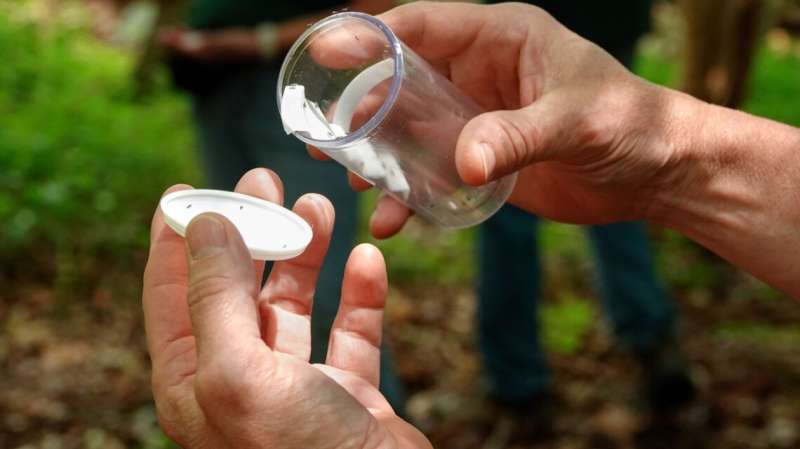This article has been reviewed according to Science X's editorial process and policies. Editors have highlighted the following attributes while ensuring the content's credibility:
fact-checked
trusted source
proofread
Silver fly takes flight in the fight to save Fall Creek hemlocks

Researchers are hoping a fly no larger than a grain of rice and a predatory beetle may work together to combat an invasive pest that is devastating hemlocks in Fall Creek and throughout eastern North America.
Cornell Botanic Gardens staff and Cornell's New York State Hemlock Initiative released 700 silver flies in the Fall Creek South Natural Area in June. The team hopes the silver flies, and a beetle released there in 2022, may offer a long-term biological solution to the hemlock woolly adelgid, which poses one of the most significant risks for hemlock populations.
While both species have been released in Cornell Botanic Gardens before, Fall Creek South is the first area where both will exist together, offering researchers insights into whether they will successfully fight the hemlock woolly adelgid.
The aphid-like species clings to hemlock branches and pierces the fine twigs to feed on the tree's sap. This disrupts the tree's flow of vital nutrients to its canopy, ultimately leading to the tree's death.
The insect has the potential to decimate hemlock forests—including the hundreds that reside in the Fall Creek area. Ranging from saplings to 300-year-old trees, hemlocks are the foundation species that shape the area's hydrology, temperature and species composition, said Todd Bittner, director of natural areas for Cornell Botanic Gardens.
"The hemlocks are iconic to these woods," Bittner said. "Hemlocks are absolutely necessary for maintaining this ecosystem and the biodiversity it supports."
The hemlock plays a crucial role in the area's ecosystem. Its dense canopy creates a cool, shaded habitat suitable for specific plants and animals to thrive. Its branching roots filter water and reduce soil erosion, increasing water quality. The tree's dense shade also delays snow melt in the spring, which provides stream-flows needed for trout and other fish.
Native to the American Northwest, both the beetle, Laricobius nigrinus, and the silver fly, Leucotaraxis piniperda, hunt adelgids and are naturally suited for a colder climate. Similar to its prey, the silver fly also reproduces twice a year, meaning it can feed on hemlock woolly adelgids as the pests reproduce.
"You have these predators that are essentially feeding on the same thing," said Nick Dietschler, research support specialist from the hemlock initiative. "In our research, we are trying to understand the niche specialization between the two species. Because they've co-evolved with each other, they're likely going to find the same niches here on the East Coast as in their native Northwest."
Cornell Botanic Gardens' natural area stewards have protected more than 2,000 trees with insecticide bark applications and trunk injections in 15 natural areas. In anticipation of biocontrol introduction, staff strategically left some hemlocks untreated. These trees will allow hemlock woolly adelgid populations to remain stable enough for predator populations to adequately establish themselves with a steady supply of food.
The short-term goal is for the predators to remain for three years, marking their establishment in the area. Researchers hope that the silver fly, a strong flier, will spread in time and aid hemlocks in the surrounding area.
Because pesticide applications last five to seven years, many trees in Fall Creek will approach insecticide reapplication within the next few years. Currently, the team plans to reassess the area in 2024, which would allow predator populations time to establish a presence there; that will help the team determine if pesticides are still required after the biocontrol agents have been released.
The long-term conservation plan for Fall Creek will depend on several factors, including predator establishment, hemlock woolly adelgid populations and the condition of the trees.
Despite the uncertainty, the mission remains steady: to conserve as many hemlock trees as possible, Bittner says.
"If in 100 years, we have hundreds of hemlocks in this area, that's a success."
Provided by Cornell University

















